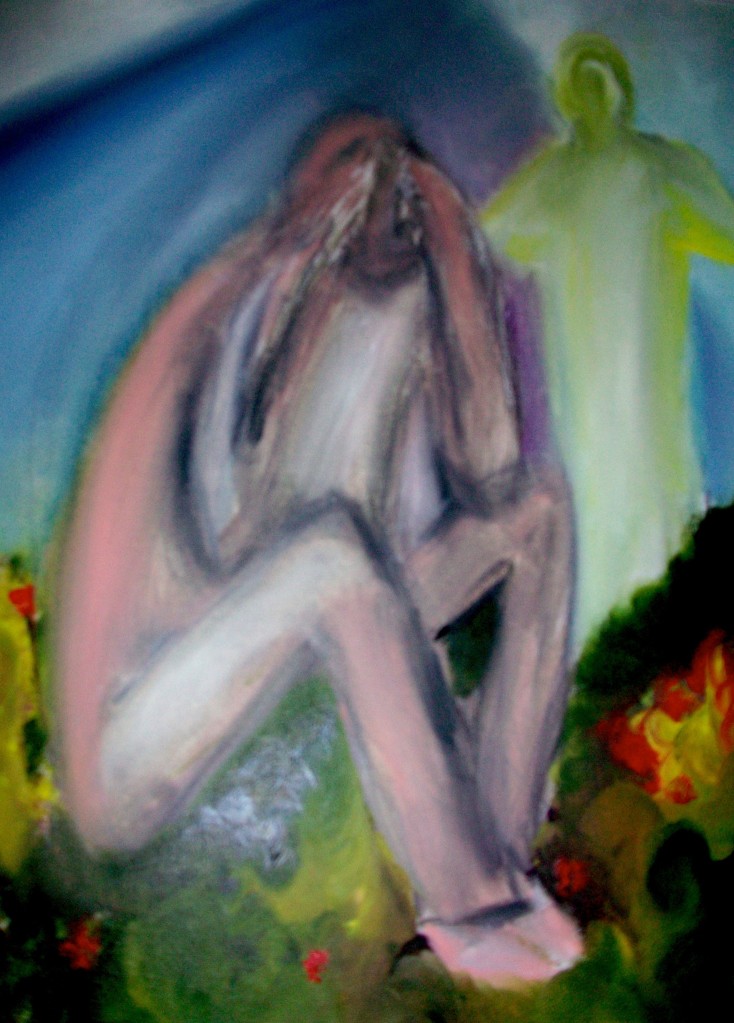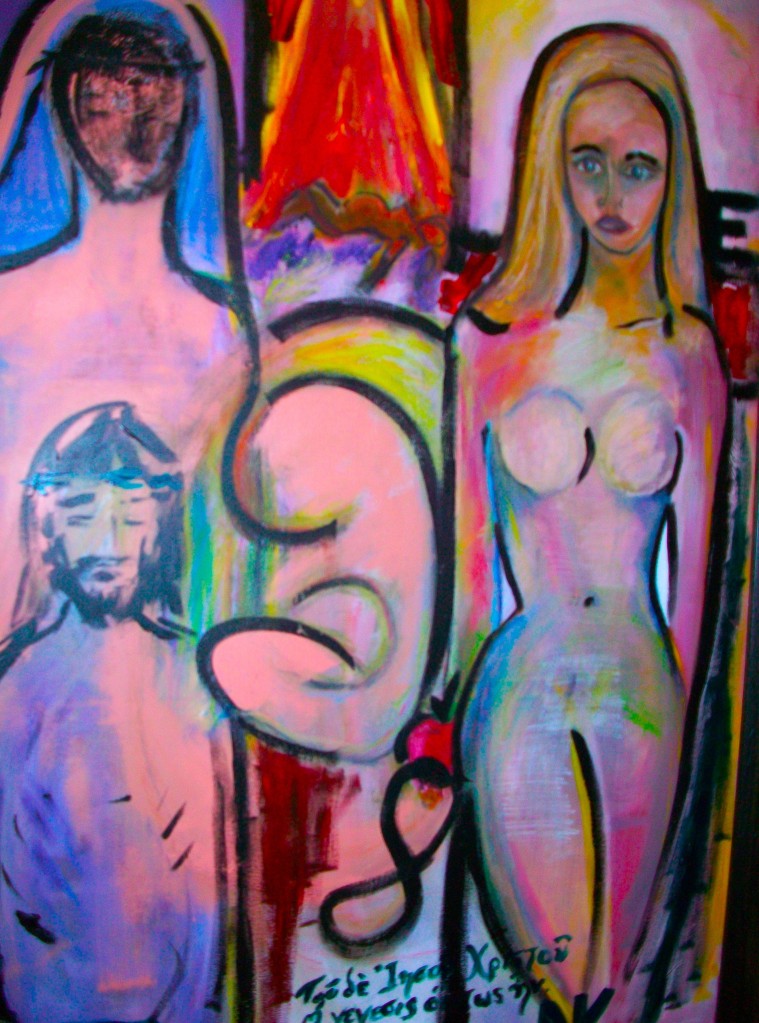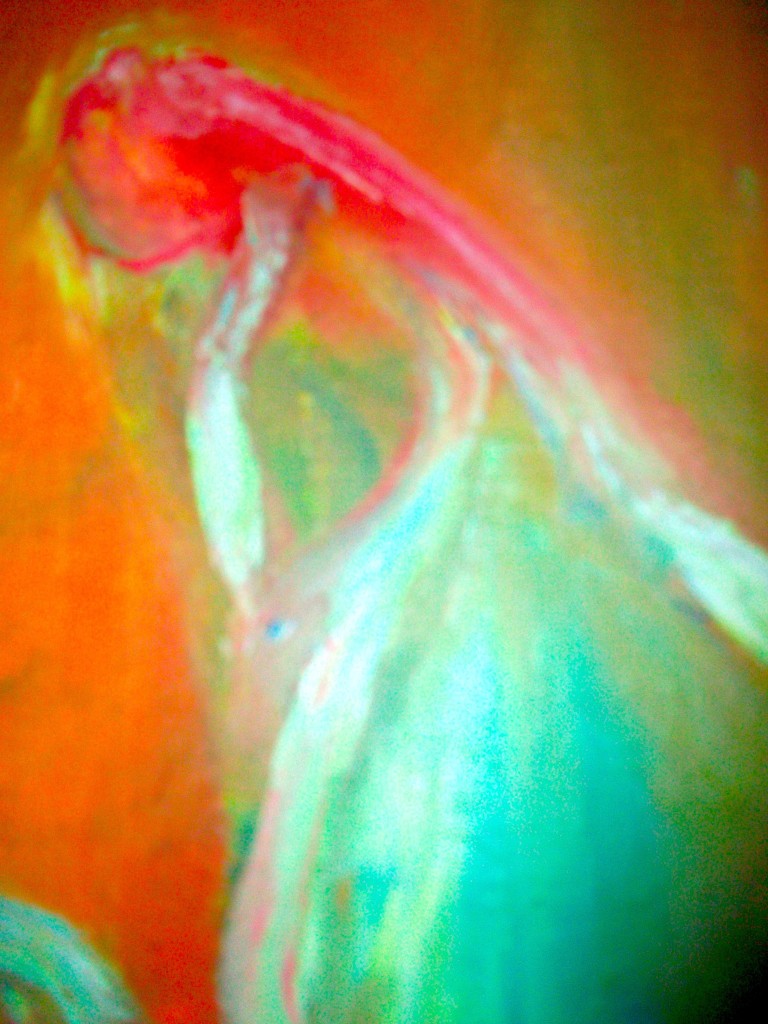 I used to paint and draw all the time as a child. I thought about majoring in art as a college student, but I went to an institution that did not have any applied arts courses in the curriculum. I had gone to college on a scholarship that I could not duplicate elsewhere, so I settled for a number of art history classes and gave up any formal pursuit of art. However, when I had my children, I rediscovered art. More accurately, I did not rediscover it so much as I fell in love anew. For, I found in working with my children a tremendous liberation. It did not matter if it was “good” or not, had the “right” form or not, used the medium “correctly” or not, or said something “properly.” I learned all over again that people could have hearts for heads; skies could rain jellybeans; and skin could be blue just because you like it that way.
I used to paint and draw all the time as a child. I thought about majoring in art as a college student, but I went to an institution that did not have any applied arts courses in the curriculum. I had gone to college on a scholarship that I could not duplicate elsewhere, so I settled for a number of art history classes and gave up any formal pursuit of art. However, when I had my children, I rediscovered art. More accurately, I did not rediscover it so much as I fell in love anew. For, I found in working with my children a tremendous liberation. It did not matter if it was “good” or not, had the “right” form or not, used the medium “correctly” or not, or said something “properly.” I learned all over again that people could have hearts for heads; skies could rain jellybeans; and skin could be blue just because you like it that way.
Doing art with my children opened up my courage to recognize creative expression as a sacramental act. Both when it is done for overtly sacred purposes as well as when it is done for more secular ones, art of all media can be an outpouring of the spirit into the material world that allows one to say to another: here I am, this is what I have felt, did you see this, I’ve been there too. Once freed from norms about how something ought to be used or made or discussed or interpreted, art has the potential to become revelatory, both of the human and also of the divine (or, perhaps better, of the human as divine).
Prompted by my recent course in sacraments and liturgy, I have been considering sacred making – that of others, that of a community, and that which I myself produce. One of my insights recently about my own art is that in some sense it has always been self-portraiture. Though it tended, at least historically, to ping pong between classically sacred imagery (crucifixes, madonnas, prayerful figures) and sensual female forms, it was all some effort on my part to say something about myself, about my desire to connect with God, and often about my loneliness in not achieving that connection in the manner in which I thought the connection was supposed to feel. For example, this image captures loosely but effectively the angst I felt as a teenager:

With this insight, I have been reviewing the kinds of images I had made over the years and was surprised to find so many that seemed to dwell in a place of spiritual pain. The fact of the pain was not so surprising to me as was the realization that these images all reflect a kind of spiritual strangulation I had or have felt in the religious narratives that organized my faith from childhood. Here are but three examples: a curious juxtaposition of faceless Mary and Eve; a self reaching out to itself choking in utero; a supplicant kneeling under the burden.



In light of this discovery, I challenged myself to endeavor making a self-portrait that was delivered of spiritual pain. I wanted to discover how I could visually represent my own interior light, the god within, the imago dei. I wanted to discover equanimity and creativity loosed from its bindings. I have to admit that I felt a little nervous, perhaps a little blasphemous, perhaps even like I was engaging in some kind of sorcery, when I came up with this:

It was a strange sacramental act for me that felt like a birth of sorts. I’m not sure that it means anything, but I know I will ask my students to try it. For, I found something stunningly liberating about re-imaging, re-narratizing, and retraining my sense of the divine. My children had interesting reactions. The youngest said, “Who’s in her mind? Is it me?” The oldest asked what was on her head. When I replied, “What do you imagine it to be?” He said, “It is her mind, and she is thinking about eternity.” My mother said, “She is free!”

To the end of re-imaging, I was at last compelled most recently to create an image of Black Jesus, who has lingered in my mind since I met him in February (see my post So Said Black Jesus). I wanted to honor that experience by rendering a beautiful, iconographic type image of Jesus in this light. As I was doing so, my children looked on in wonder, both learning and teaching beyond their years. The youngest said, “Jesus has light skin, doesn’t he?” I answered, “Couldn’t he be anything?” The oldest, after a moment of thought, said, “Oh, I see. Even though they tell us he’s white, he isn’t really, right? He’s whatever you look like.” To which the youngest said, “ Well, I think he’s beautiful (pause) because you made him. And, He’s golden, and that makes him second only to God.”
Natalie Kertes Weaver, Ph.D., is Chair and Professor of Religious Studies at Ursuline College in Pepper Pike, Ohio. Natalie’s academic books include: Marriage and Family: A Christian Theological Foundation (Anselm, 2009); Christian Thought and Practice: A Primer (Anselm, 2012); and The Theology of Suffering and Death: An Introduction for Caregivers (Routledge, 2013). Natalie’s most recent book is Made in the Image of God: Intersex and the Revisioning of Theological Anthropology (Wipf & Stock, 2014). Natalie has also authored two art books: Interior Design: Rooms of a Half-Life and Baby’s First Latin. Natalie’s areas of interest and expertise include: feminist theology; theology of suffering; theology of the family; religion and violence; and (inter)sex and theology. Natalie is a married mother of two sons, Valentine and Nathan. For pleasure, Natalie studies classical Hebrew, poetry, piano, and voice.
Discover more from Feminism and Religion
Subscribe to get the latest posts sent to your email.


I feel the same about my poetic practice which I think I am only just beginning to feel free about after more than 30+ years of writing. I’m on to my second year of a poem a day (I did this in 2009 and am doing it again in 2016). Quite an experience.
LikeLike
Blessings on your journey. Takes my breath away.
I intended to major in art, but “learned” to put the Word above the Flesh in my fresh(wo)man year.
LikeLike
Thanks Natalie. What a wonderful insight you’ve shared here and your art works too so powerful and deep!
LikeLike
strong images, Natalie. Thank you for sharing.
LikeLike
I’m glad you found your inner artist when you were a child and glad you found her again. Paint on!
LikeLike
Indeed paint on! The images are beautiful. A discussion amongst other artists some time ago had the theme of artistic practice, religion (any kind) and healing as working from the same source, the same nerve, going about the various practices differently but to serve the same end, i.e. realising the Divine, within and the Big One.
As far as the Black Jesus is concerned, there is a school of thought that Jesus may have been a black man, from an area what is now known as Ethiopia. It’s a real premise. And that your child mentioned him being as golden is just beautiful. You paint well.
LikeLike
Thank you Natalie for this beautiful and inspiring essay.
LikeLike
Natalie —
Thanks for this post. Your description of how you “found” art again when you had children really resonated with me. When I got my first “B” in 7th grade art, I decided I wasn’t good at it. But when my daughter wanted me to do art and crafts projects with her, I LOVED it. Eventually when she outgrew my abilities at about 12 or 13, it was very sad for me. These days I don’t make enough time for myself to do crafts (because of editing my book), but when I do, I still love it. Without her I would never have returned to this joy in my life.
My daughter is a painter. She did the illustrations for my book, paintings that I think are very spiritual. But what she considers her art seems to me to be disconnected from her spirit, and that surprises me and also makes sense to me. She’s involved in an art conversation that is trying to deal with the concept that “painting is dead.” As a result, she’s disrupting the viewer’s expectations about what painting is. It’s intellectual stuff (and probably something she’s passionate about as well). But for me it doesn’t resonate as much as her illustrations for my book. Like you, I believe that art can be a spiritual expression.
LikeLike
Thank you, Natalie for sharing this very poignant and insightful reflection on your personal art and art as sacramental, contemplating the Divine. I am grateful that your path still includes a desire to encounter God through an art form like the paintings above and that the class gave that desire new energy. I look forward to future observations of the inner and outer world.
LikeLike
I can relate very much to your detachment of the status quo and the preconceived barriers it brings to aesthetics. The wording you choose paints a great portrait, no pun intended, since once you have detached yourself from attempting to create what is expected, then the true self becomes the artist whether in the secular or divine, as you genuinely describe. The connection to the divine (if thou believes) through one’s own personal art, is profoundly liberating and ineffable. The examples that you share of your children are very kind, and a lovely example of the types of examples and mindsets we as adults should share with young ones when applicable.
LikeLike
Natalie,
Thank you for sharing this post, I can personally relate to you and how you lost your pursuit of art. As I grow older, I am starting to stray away from making and appreciating the arts. Life just gets in the way and there’s just not enough time in a day to accomplish everything that I want to accomplish. Your personal insight on Jesus and the way you have recreated and depicted Him really hit me hard. It never occurred to me how he was always depicted as white and never any other race! I also love the way you painted your self portrait, incorporating the part where we can see inside that allows us to have our own idea of imagining what is going on.
LikeLike
Thank you for sharing your story with us. I Feel as though I have had to deal with the idea of how I see myself and how this vision correlates to my god as well as my idea of this being. I have seen god as a figure who does not possess a gender but when referring to god i use the pronoun he. Which to me was a strange idea because i have never thought as god as a man but just as a being. I started to think of how my own struggles would align with god’s teaching as well as the teachings i have been taught as a child. Many of the ideas I have learned do not correlate with my personal connection with god but that doesn’t mean that god is not there nor does it mean god is not accepting of me. Each person fosters their specific way and some do not see god to be there at all but a person has the right to interpret this connection as they see fit.
LikeLike